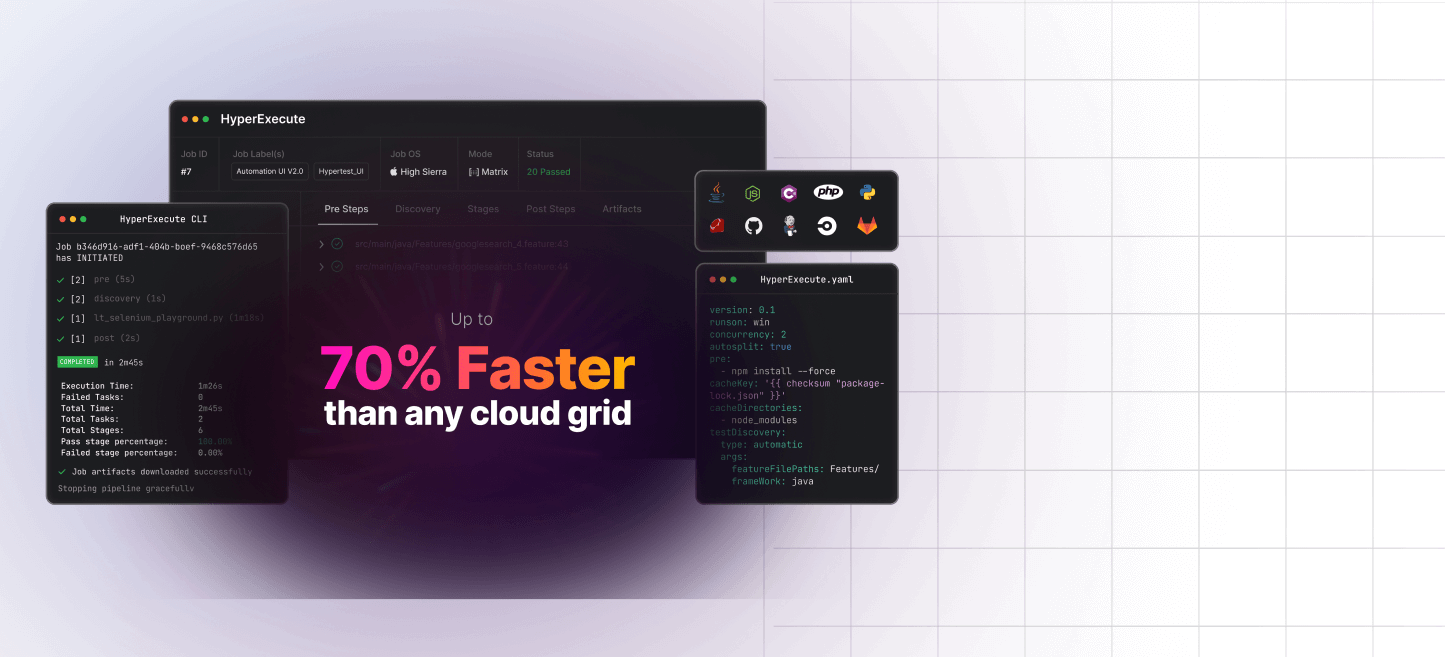HyperExecute For Microsoft Enterprises
Sign up and get FREE access to 3 parallel sessions of HyperExecute,

Playwright
Experience blazing-fast test execution of your Playwright tests with HyperExecute, a next-gen, E2E test orchestration cloud which is up to 70% faster than any cloud grid.

Azure DevOps
Accelerate your Azure Pipelines by leveraging HyperExecute, a next-generation, end-to-end test orchestration cloud which is up to 70% faster than any cloud grid.

GitHub
Fasttrack your GitHub builds by leveraging HyperExecute, a next-generation, end-to-end test orchestration cloud which is up to 70% faster than any cloud grid.
GLOBAL ENTERPRISES RELY ON LAMBDATEST FOR TEST EXECUTION



2 Million+
Users
10000+
Enterprises
132+
Countries

HyperExecute - Our Fastest Test Execution Platform
A next-generation test execution platform for agile QA teams. Test execution on cloud that matches local test execution speeds, and costs as much as a flexible spot instance cloud.

Speed Up Your Playwright Tests By 3X
Limited time offer for Microsoft Enterprises.
Last date to claim: 31st Dec'22.
Fasten Your Azure DevOps Builds by 3X
Run your Azure DevOps test builds on the fastest test execution platform online and trim down your test execution time significantly.
Offer ends on 31st Dec'22.


Accelerate Your GitHub Builds by 3X
Limited time offer for Microsoft Enterprises.
Last date to claim: 31st Dec'22.
How HyperExecute Works?
Get the best of both worlds—speed of a local setup and the smartness of a cloud grid—with HyperExecute.
Why HyperExecute for Automated Test Execution
Get the best of both worlds—speed of a local setup and the smartness of a cloud grid—with HyperExecute.

Smart Workflows
Set up automatic sequencing, static and dynamic test discovery, static data splitting and more. And best of all, set up intelligent retries of tests.

Dependency Caching
Caches all environment and framework-level dependencies to ensure all your subsequent test runs don't require configuration or even installation steps.

Command-Lined Binary
HyperExecute CLI, allows you to trigger tests on HyperExecute cloud from your local system and CI alike. Making it intuitive to adopt and integrate in any environment.

Smart CI features
HyperExecute helps you hit the right APIs, preparing the test data, and generating post-testing analytics, among other features, to assure you a swift go-to-market.
Frequently
asked questions
- About Offer →
- General
- Features
- Platform
- Pricing
- Security
- Enterprise
https://github.com/actions/virtual-environments/blob/main/images/macos/macos-11-Readme.md
https://github.com/actions/virtual-environments/blob/main/images/win/Windows2019-Readme.md
https://github.com/actions/virtual-environments/blob/main/images/linux/Ubuntu2004-Readme.md
We use github’s open source images for github actions and pre-installed softwares. Visit the links to view the list of pre installed softwares
HyperExecute access from this offer will be applicable only for -
1. Playwright Tests, or
2. Tests from any framework triggered via Azure Pipeline or GitHub Actions
- HyperExecute CLI : Please refer to this doc for more information and download options.
- Username and Access key for triggering test cases on HyperExecute upon signing up on Lambdatest.
